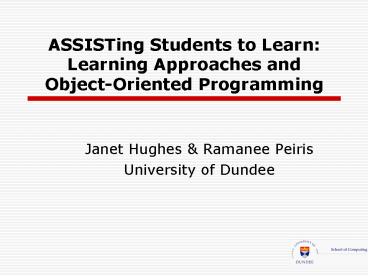ASSISTing Students to Learn: Learning Approaches and ObjectOriented Programming - PowerPoint PPT Presentation
1 / 16
Title:
ASSISTing Students to Learn: Learning Approaches and ObjectOriented Programming
Description:
Learning styles are considered to be intrinsic behaviours habitually applied by learners. Learning approaches describe tendencies that are not immutable. ... – PowerPoint PPT presentation
Number of Views:54
Avg rating:3.0/5.0
Title: ASSISTing Students to Learn: Learning Approaches and ObjectOriented Programming
1
ASSISTing Students to LearnLearning Approaches
and Object-Oriented Programming
- Janet Hughes Ramanee Peiris
- University of Dundee
2
Outline
- Introduction
- Method
- Results
- Discussion
3
Background who is at risk?
- Widespread evidence of inadequacy of expected
predictors - Mathematics experience
- Academic qualifications
- Gender
- Educational / social background
- Prior programming experience
4
Background who is at risk?
- Now consider attitudes to learning
- Learning styles are considered to be intrinsic
behaviours habitually applied by learners. - Learning approaches describe tendencies that are
not immutable. - students also seem to develop habits in studying
which may lead them to rely more on one or other
approach (Entwistle, 1996)
5
Approaches to Learning
- (i) a deep approach intention is to understand
and relate ideas evidence is considered - (ii) a strategic approach focuses upon
achievement aim is to achieve the highest
possible grades includes considered time
management and alertness to assessment demands - (iii) a surface apathetic approach features
memorizing and reproducing intention is to cope
with course requirements
6
ASSIST Approaches Study Skills Inventory for
Students
- What is learning
- 6 statements
- Approaches to Learning
- 52 statements
- Preferences for different types of course and
teaching - 8 statements about
- All responses via 5-point Likert scale
7
Examples
In terms of this particular lecture course
- I usually set out to understand for myself the
meaning of what we have to learn - When working on an assignment, I'm keeping in
mind how best to impress the marker - I find I have to concentrate on just memorising a
good deal of what I have to learn - Agree / Agree somewhat / Unsure / Disagree
somewhat / Disagree
8
Calculations
- 52 statements each belongs to one of the 3
learning approaches - Answers scored 1disagree to 5agree
- Summed within each learning approach
- Example
- Qs 3, 17 26 are for deep learning
- Then Deep score A3 A17 A26
9
Now
- Identify surface learners
- Advise about alternative approaches
- Web-based catalogue of deep learning activities
relevant to OO programming - designed in a wiki-web fashion
- contributions from students and staff
- http//www.computing.dundee.ac.uk/projects/learn/w
ikiasp/
10
Analysis
- Scores revealed at end with explanation and some
analysis
11
ResultsASSIST scores and module grades
12
Discussion surface learning
- Surface learning correlates with poor performance
in programming. - Can we generate interventions that support
students learning to program?
13
Questions?
- Janet Hughes
- jhughes_at_computing.dundee.ac.uk
- Ramanee Peiris
- rpeiris_at_computing.dundee.ac.uk
University of Dundee Scotland
14
Approaches to Learning
- (i) a deep approach, intention is to understand
and relate ideas, and where evidence is
considered - (ii) a strategic approach, which focuses upon
achievement, aim is to achieve the highest
possible grades, includes considered time
management, and alertness to assessment demands - (iii) a surface apathetic approach, which
features memorizing and reproducing, intention is
to cope with course requirements
15
ASSIST Approaches Study Skills Inventory for
Students
- What is learning
- 6 statements
- Approaches to Learning
- 52 statements
- Preferences for different types of course and
teaching - 8 statements about
- All responses via a 5-point Likert scale
16
Examples
- In terms of this particular lecture course
- I usually set out to understand for myself the
meaning of what we have to learn - When working on an assignment, I'm keeping in
mind how best to impress the marker - I find I have to concentrate on just memorising a
good deal of what I have to learn - Agree / Agree somewhat / Unsure / Disagree
somewhat / Disagree































